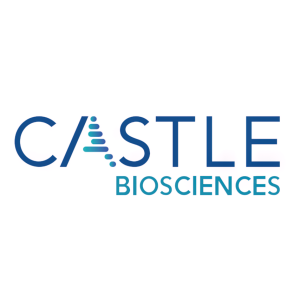Data from Independent, Pooled Analysis Show Significantly Improved Risk Predictions Over Clinical Variables for TissueCypher® Barrett’s Esophagus Test and Ability to Identify Patients at High Risk of Progressing to Esophageal Cancer
Castle Biosciences (CSTL) announced a peer-reviewed study published in Clinical Gastroenterology and Hepatology, demonstrating that their TissueCypher test significantly enhances predictions for patients with Barrett's esophagus at risk of developing esophageal cancer.
The study included data from 552 patients, revealing that 51.8% of those diagnosed as non-dysplastic progressed to high-grade dysplasia or cancer. TissueCypher outperformed traditional evaluations, supporting its integration into clinical practice for better risk management.
- TissueCypher significantly improves predictions of cancer progression in Barrett’s esophagus patients.
- Study data shows 51.8% of NDBE patients at risk were identified by TissueCypher, a critical improvement over standard care.
- TissueCypher's high-risk score strongly correlates with progression risk, enhancing the existing clinical evaluation process.
- None.
Insights
Analyzing...
The study data reinforce the value of TissueCypher in helping physicians and patients make more informed management decisions based on the unique biology of individual patients’ esophageal biopsies
“One of the most critical challenges in the management of the nearly 384,000 patients with Barrett’s esophagus who undergo an endoscopy each year is determining which are at risk of progression to esophageal cancer,” said
“Of particular importance in this study was the ability of the test to identify high-risk patients who progressed to high-grade dysplasia (HGD) or esophageal cancer, yet were initially diagnosed as non-dysplastic BE (NDBE),” said
“TissueCypher has the potential to help change this,” added Maetzold.
In the manuscript titled, “Prediction of Progression in Barrett’s Esophagus Using a Tissue Systems Pathology Test: A Pooled Analysis of International Multicenter Studies,” Iyer et al. at
In the study,
In the study, a TissueCypher high-risk score independently predicted increased risk of progression to HGD/esophageal cancer (OR=6.0,
About TissueCypher® Barrett’s Esophagus Test
The TissueCypher® Barrett’s Esophagus test is Castle’s precision medicine test designed to predict future development of high-grade dysplasia (HGD) and/or esophageal cancer in patients with Barrett’s esophagus (BE). The TissueCypher Barrett’s Esophagus test is indicated for use in patients with endoscopic biopsy confirmed BE that is graded non-dysplastic (NDBE), indefinite for dysplasia (IND) or low-grade dysplasia (LGD); its clinical performance has been supported by eight peer-reviewed publications of BE progressor patients with leading clinical centers around the world. The TissueCypher Barrett’s Esophagus Assay is a proprietary Laboratory Developed Test with its own unique CPT PLA code (0108U) and has been on the Medicare Clinical Laboratory Fee Schedule since
About
Castle’s current portfolio consists of tests for skin cancers, uveal melanoma, Barrett’s esophagus and mental health conditions. Additionally, the Company has active research and development programs for tests in other diseases with high clinical need, including its test in development to predict systemic therapy response in patients with moderate-to-severe psoriasis, atopic dermatitis and related conditions. To learn more, please visit www.CastleBiosciences.com and connect with us on LinkedIn, Facebook, Twitter and Instagram.
DecisionDx-Melanoma, DecisionDx-CMSeq, DecisionDx-SCC, myPath Melanoma, DecisionDx DiffDx-Melanoma, DecisionDx-UM, DecisionDx-PRAME, DecisionDx-UMSeq, TissueCypher and IDgenetix are trademarks of
Forward-Looking Statements
This press release contains forward-looking statements within the meaning of Section 27A of the Securities Act of 1933, as amended, and Section 21E of the Securities Exchange Act of 1934, as amended, which are subject to the “safe harbor” created by those sections. These forward-looking statements include, but are not limited to, statements concerning: TissueCypher’s ability to identify patients with a high risk of progressing to HGD or esophageal cancer and provide opportunities for early interventions that could potentially prevent progression to esophageal cancer or increase chances of survival; the test’s ability to help physicians and patients make more informed management decisions based on the unique biology of individual patients’ esophageal biopsies by risk-stratifying patients for progression. The words “potential,” “can” and similar expressions are intended to identify forward-looking statements, although not all forward-looking statements contain these identifying words. We may not actually achieve the plans, intentions or expectations disclosed in our forward-looking statements, and you should not place undue reliance on our forward-looking statements. Actual results or events could differ materially from the plans, intentions and expectations disclosed in the forward-looking statements that we make. These forward-looking statements involve risks and uncertainties that could cause our actual results to differ materially from those in the forward-looking statements, including, without limitation: the effects of the COVID-19 pandemic on our business and our efforts to address its impact on our business; subsequent study results and findings may contradict earlier study results and findings, including with respect to the TissueCypher test discussed in this press release; actual application of our tests may not provide the aforementioned benefits to patients; and the risks set forth under the heading “Risk Factors” in our Annual Report on Form 10-K for the fiscal year ended
View source version on businesswire.com: https://www.businesswire.com/news/home/20220427005339/en/
Investor Contact:
czuckero@castlebiosciences.com
Media Contact:
amarshall@castlebiosciences.com
Source:







